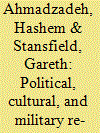| Srl | Item |
| 1 |
ID:
101289


|
|
|
|
|
| Publication |
2010.
|
| Summary/Abstract |
The two decades, 1925-45, witnessed a dramatic transformation and revitalization of the Persian carpet industry in response to developments in Iranian governance, society and economy. Two historical watersheds were covered by that period, notably the replacement of the Qajar dynasty by a modernizing administration under Reza Shah Pahlavi, and the subsequent wartime occupation of Iran jointly by the Soviet Union and Great Britain. It was during those two decades that Iran acquired a centralized system of government and the beginnings of a modern industrial base. The accompanying social transformation brought about the emergence of new classes of administrators and managers who constituted the dominant elite of the Reza Shah era. This twin process of centralization and modernization had a telling impact on Iranian culture and the arts, including the carpet arts.
|
|
|
|
|
|
|
|
|
|
|
|
|
|
|
|
| 2 |
ID:
094615


|
|
|
|
|
| Publication |
2010.
|
| Summary/Abstract |
This article aims to shed light on the modern history of the Kurds in Iran, with particular reference made to the main Kurdish political and social movements of the 20th century following World War I and the establishment of an Iranian nation-state. The modernization and centralization of the new state deprived the non-Persian ethnic groups, including the Kurds, of democratically expressing their national aspirations. The consequences of this policy and the struggle of the Kurds against it throughout the remainder of the century and up to the present are the main issues discussed in this article.
|
|
|
|
|
|
|
|
|
|
|
|
|
|
|
|
| 3 |
ID:
093484


|
|
|
|
|
| Publication |
2010.
|
| Summary/Abstract |
The paper reconsiders the apocryphal stories regarding the Shahnama's initial reception to propose that it was only after long narrative poems gained currency that the Shahnama was recognized as a masterpiece. The paper analyzes the structure and themes of several histories written before and during the Samanid period and compares them with the Shahnama and the content of histories and epics produced immediately afterwards, to argue that the initial reception of the Shahnama did not depend on Sultan Mahmud Ghazni alone. It further argues that the Shahnama's aim, content, and execution differed from the histories and poetry produced in the decades immediately preceding and succeeding it, which would account for the lag in its acceptance and popularity. This led later biographers to superimpose their regret over Firdausi's treatment onto Sultan Mahmud Ghazni, who by their accounts denied him the fame and glory he deserved in his lifetime.
|
|
|
|
|
|
|
|
|
|
|
|
|
|
|
|